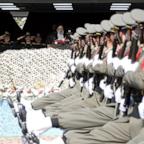Shipwreck off Namibia is 500-year-old treasure trove
JOHANNESBURG, South Africa -- The ship was laden with tons of copper ingots, elephant tusks, gold coins — and cannons to fend off pirates lurking off Africa some five centuries ago.
It had nothing to protect it from the fierce weather off a particularly bleak stretch of inhospitable coast. It sank, only to be found last month by men seeking other treasure.
"If you're mining on the coast, sooner or later you'll find a wreck," archaeologist Dieter Noli, who is researching the ship's origins, said in an interview Thursday, describing De Beers geologists stumbling on the wreck April 1 as they prospected for diamonds off Namibia's southwest coast.
Namdeb Diamond Corp., a joint venture of the government of Namibia and De Beers, first reported the find in a statement Wednesday, and planned a news conference in the Namibian capital on the discovery next week.
Namdeb had cleared and drained a stretch of seabed, building an earthen wall to keep the water out so geologists could work. Noli said one of the geologists first saw a few ingots, but had no idea what they were. Then they found what looked like cannon barrels, but weren't sure.
The geologists stopped the brutal earth moving work of searching for diamonds and sent photos to Noli, who had done research in the Namibian desert since his university days in Cape Town in the mid-1980s and since 1996 has advised De Beers on the archaeological impact of its operations in Namibia.
The find "was what I'd been waiting for for 20 years," Noli said. "Understandably, I was pretty excited. I still am."
Noli's original specialty was the desert, but because of Namdeb's offshore explorations, he had been preparing for the possibility of a wreck, even learning to dive. He had also studied maritime artifacts with Bruno Werz, a recognized expert in the field who was one of his instructors at the University of Cape Town. Noli brought in Werz to help research the Namdeb wreck.
Judging from the notables depicted on the hoard of Spanish and Portuguese coins and the type of cannons and crude navigational equipment, the ship went down in the late 1400s or early 1500s, around the time Vasco de Gama and Columbus were plying the waters of the New World, "a period when Africa was just being opened up, when the whole world was being opened up," Noli said.




